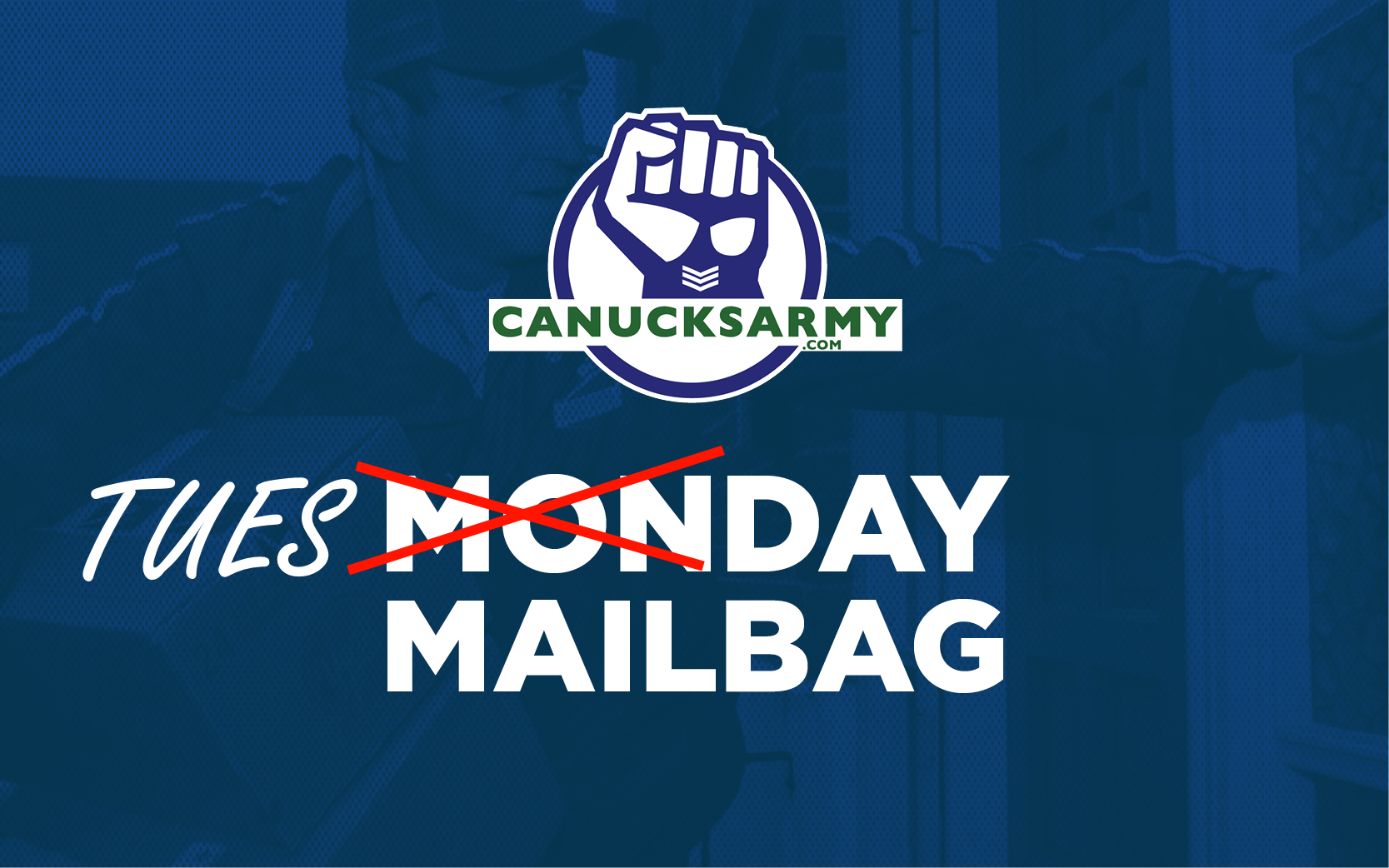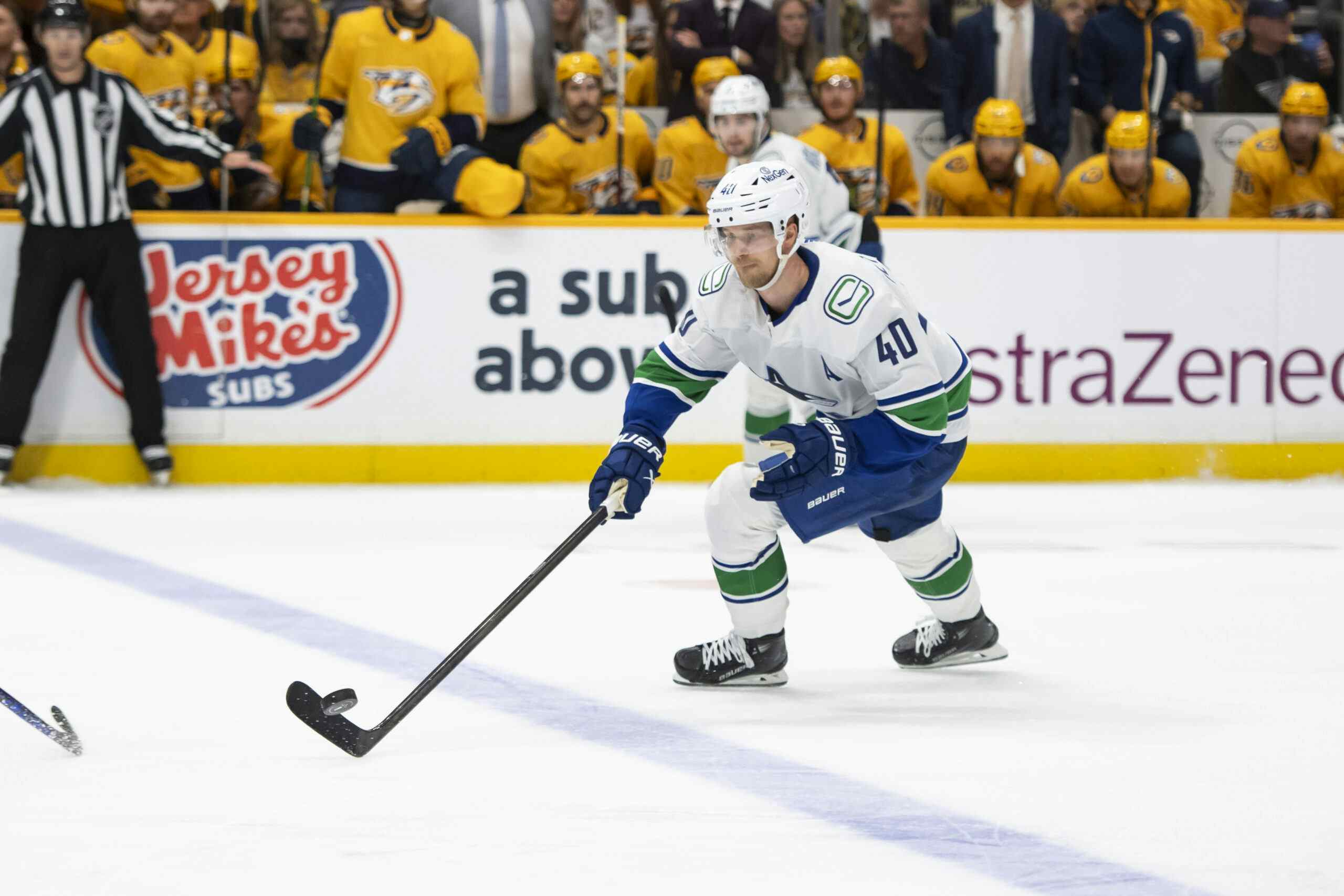Deep Dive: The Canucks Might Have Something in Philip Holm
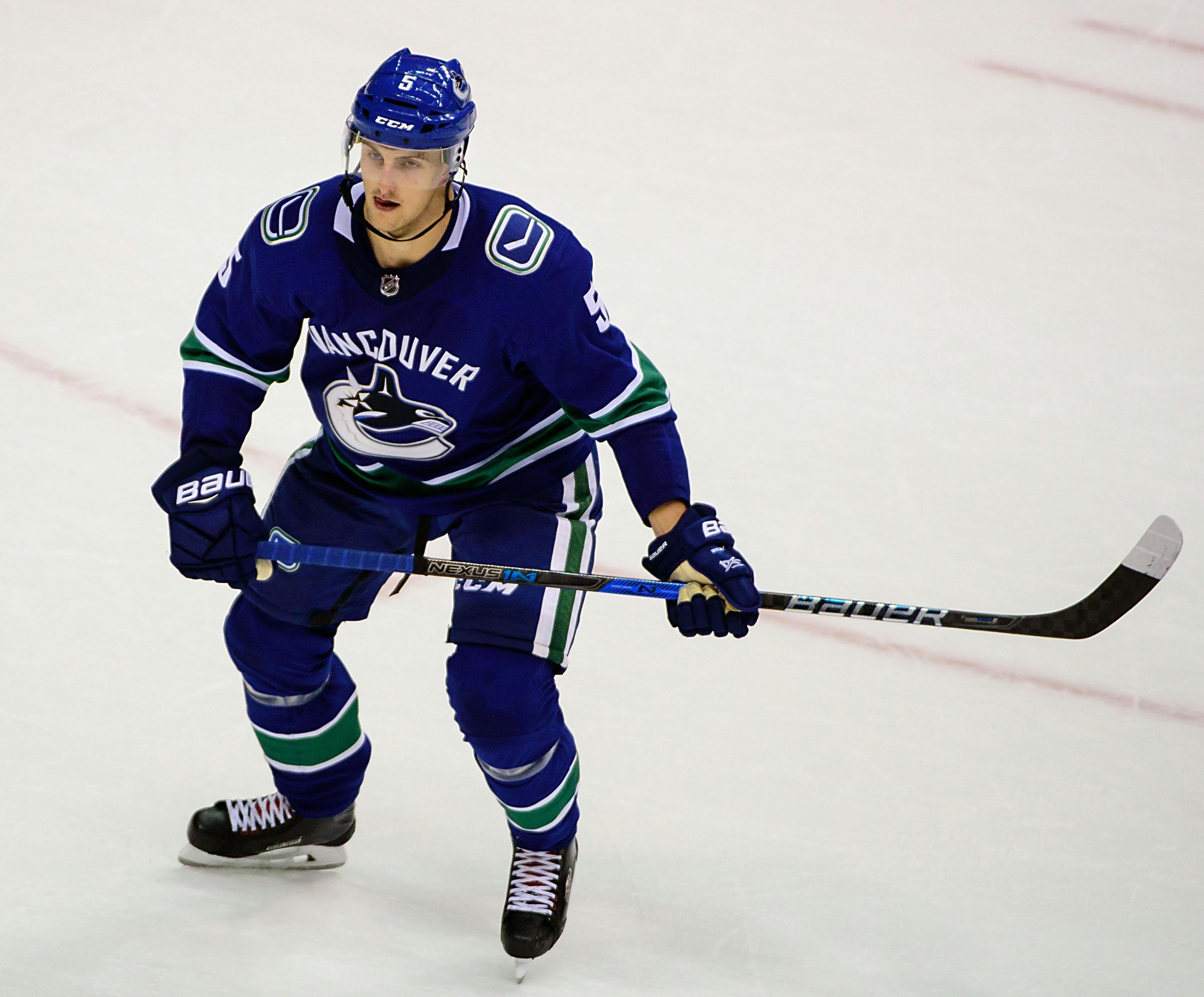
6 years ago
This Philip Holm defenceman that the Canucks signed in the off-season to add to their blue line depth is pretty good, it turns out.
His signing was fairly unheralded in this market as it happened in May and the Canucks had just finished a terrible season. Fans were looking to the future, and a 25-year-old defenceman from Sweden seemed more like a ‘now’ move than one for the future.
Holm came into training camp and struggled at first. He had never played in the North America, and it was clear that Holm would need time to adjust to the different size of the rink. It didn’t help that the Canucks had a split squad for the majority of training camp, meaning they had to lean heavily on Holm.
Miscues were evident, but there was still some things to like about Holm’s game. Most of those issues were likely due to him adjusting to the speed of the NHL game and the size of the rink.
I intended to write about Holm before the season, but his pre-season performance scared me off. I didn’t want a Philip Larsen is adequate moment. Now that we are a few games into the Comets season, I have a larger sample size to back up my assertions.
Comets head coach Trent Cull is a fan. The Comets are leaning on Holm in a big way, as he’s played on the top pair and taken on first unit penalty kill and power play duties. That gives us a lot of video to showcase his skill set and why he’s someone to follow for this season and next.
Holm’s game is not perfect and there are flaws. This article is intended to be comprehensive of his entire game, so there will be good parts, bad parts, recoveries and mistakes throughout all the clips.
Stats
We’ve already acknowledged Holm’s pre-season struggles and why they occurred, so I won’t linger any longer on that point. However, noticeable gaffes and all, Holm still shows reasonably well in totality and only improved as the exhibition games near neared their end. Darryl Keeping has been tracking zone exits for the Canucks since the start of the pre-season and was kind enough to provide the data for the exhibition games for the ‘depth defenders’:
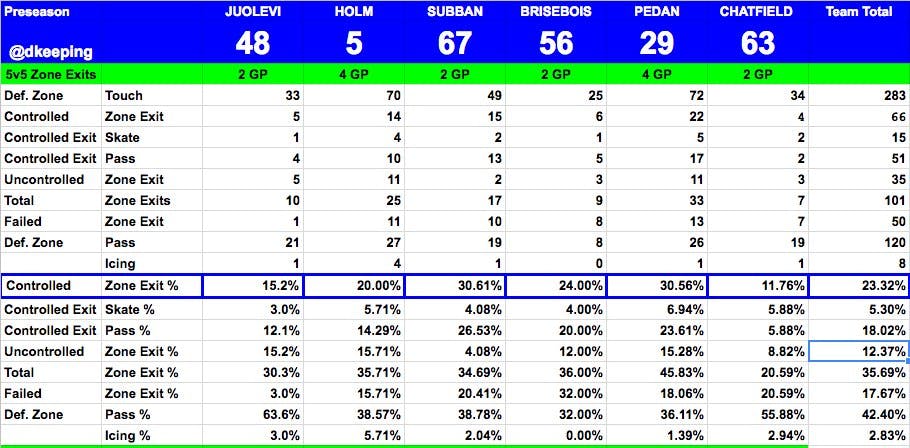
In four games with the Canucks, Holm excelled at passing the puck out of the zone to his teammates and kept his turnover rate low. He carried the puck out close to the average (of these players) and had a higher icing and uncontrolled zone exit rate. All of that is to say that Holm was moving the puck out of the zone well, with some misses and some off the glass and out exits. Hardly a concerning level of miscues but worth noting.
With one goal and seven assists, Holm is currently eighth in AHL defenceman scoring. He is currently 26th amongst that same peer group in shots. It’s interesting to note, as that is something that stands out about his game is getting his shot through. Obviously given his ranking, we’d like to see it more, as he does have a knack for getting the puck through (something I’ve highlighted). He has been generating more shots recently with an average of 3.25 shots per game over the last four games.
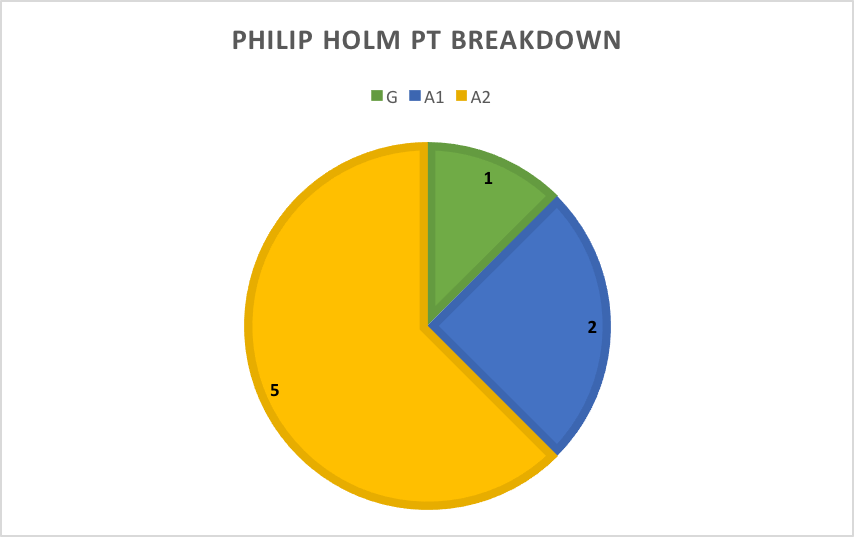
A significant portion of his production is secondary assists, with his goal and three assists coming on the powerplay. We are dealing with a small sample size here, so I wouldn’t read too much into it.
Defensive Play
Entering the season, there were definitely questions about who would be on the Comets top pair for this season. With an influx of rookies, the veterans were now players who had been in Utica for a year or two. So it’s no wonder why Cull turned to Holm to immediately to carry the load.
The young Swede is a veteran of 197 games in the SHL and thus is the most experienced of the group — aside from AHL vet Jamie Sifers. Holm has been primarily playing with Guillaume Brisebois but has also played with Evan McEneny and Jordan Subban when Brisebois is a healthy scratch. Of all the defencemen, Holm is the only one not to be scratched.
With Cull leaning on Holm quite a bit, this means Holm is playing a lot against the other team’s top players. A couple of plays have stood out to me, and they stem from Holm’s active stick.
Here is a play from the October 7th, the Comets season opener against the Toronto Marlies.
Marlies winger Andreas Johnsson receives the pass as soon as they enter the zone, and appears ready to cut in for an opportunity. Holm is able to stop before the attack and then poke the puck off Johnsson’s stick. After a couple of bounces, Holm pivots around to face the puck and chips it up. Obviously, if Holm had missed with the poke, Johnsson would’ve had space right in the slot — it’s not a perfect play. But the calmness that Holm shows to shut it down is worth the highlight.
Another consistent part of Holm’s defensive game that has stood out to me has been that he will tie up an opponent’s stick. The clip below is from the October 7th game against Toronto:
Holm engages Marlies forward Colin Greening in the corner, losing the battle as Greening is as able to hold Holm away from the puck and then send it to his teammate Chris Mueller. But as they come out of the corner, Holm recognizes that Greening is still his man. He lifts and ties up the stick, then guides him behind the net, effectively eliminating him from the play. Another play where this occurs without the desired result is from October 29th vs Charlotte:
The Checkers get the puck out with a bouncing puck that Brisebois has trouble corraling. Checkers forward Clark Bishop lifts his stick and is able to create a outnumbered situation. Holm eliminates the threat of Zack Stortini by tieing up his stick, but that also limits Holm’s ability to check Bishop or the goal scorer Michael Forrentino. The breakdown was quick and resulted in Zack MacEwen and Brisebois being a step behind their checks. This isn’t a terrible look on Holm as the situation fell apart quickly.
Another play from that October 7th game, Holm and Brisebois are caught in a two-on-three rush in transition. Brisebois attacks the puck carrier, so Holm takes the highest threat, which is Marlies winger Kasperi Kapanen in the middle. Lifts his stick and moves him out of the way. It’s not a perfect play, as Michael Chaput is quite a distance from Kerby Rychel and if the pass got through, Rychel has a good lane to the net. Holm is able to generate enough speed backward (along with Brisebois) to still be in control of the attack. He eliminates the highest threat before it’s even an issue and because Brisebois is able to tip the puck out of play, nothing comes of it.
You’ll notice that Holm’s ability to read the play and his awareness are a consistent theme throughout. A break by the Charlotte Checkers during the October 28th game showcases that in his defensive play.
Checkers forward Andrew Poturalski gets the puck in front of Holm in the Checkers zone. Rather than engaging the forward and taking himself out of the play, Holm rolls off and gets on his horse back. Aleksi Saarela and Andrew Miller quickly lose Boucher, but Holm cuts off Miller’s lane forcing the puck back to Saarela, who draws a penalty from Brisebois.
When looking at Holm, his awareness that he has already lost the engagement with Poturalski, before it even began, and rolls off to get back is great to see. Obviously having a penalty called isn’t the best outcome, but Brisebois got caught a step behind as he was about to pinch. Holm eliminated the threat from his standpoint by quickly changing his mind.
Lastly, I really liked this play from Holm from the November 1st game against Rochester. Wacey Hamilton’s shot is blocked, Holm gets on his horse, cuts the angle and guides the Americans forward into the corner. No penalty was taken, no real threat, and all from a smart and efficient elimination of the break.
Offensive Play
Two things stand out about Holm’s offensive abilities at even strength: his ability to get a shot through and his ability to read the play, which allows him to pinch or retreat at the right times. Unless there is a breakdown, Holm is usually on the right side of the puck and has timed his engagement well.
An example of Holm rushing the puck and getting a shot on net comes from the October 29th contest against the Charlotte Checkers:
I Included some of the play in his own zone here. Holm turns his back on the forechecker, then gets it out. There is a bit of a puck battle in the neutral zone, while out of frame, Holm loops around and skates up. Holm is open along the boards, keeping his head up the whole time. He notices Zack MacEwen on the far side, shoots it directly at Jeremy Smith’s pad, who kicks it out to MacEwen. What really stands out about this play is Holm has his head up the entire time and makes the smart decision to generate a second chance.
Shots are good. We know that from when you first start playing — get pucks to the net, and good things happen. This play from the October 14th game against Syracuse was worth noting:
It’s a simple play, but a stutter step to the side to adjust the lane on two separate occasions. It can be frustrating to have defencemen just fire the puck into the shin pads of the high guy, so just simply getting it through is an encouraging thing to see.
Powerplay
Philip Holm has been a staple of the first powerplay unit for the Comets. Primarily running a 1-3-1 setup, Holm and Nikolay Goldobin have been on the point until setting up. Goldobin slides down to the left half boards to control the attack, and then Holm shifts to the top. During 5v3 man advantages, Holm has been on the right point with Boucher on the left side, and Goldobin slides down further on the left side.
This sequence from the October 7th game against the Marlies stood out to me.
Holm avoids the pressure on the Comets point, chips and chases forcing a turnover. He rolls off and heads back to the point to be open for pass, which he receives and sends to Boucher to allow the Comets to setup.
The clip below is a good window into why the Comets powerplay has been so successful this season, and why Holm is a big part of it. This clip is from the November 4th game against the Rochester Americans:
Focusing on Holm — he gets the first shot through. After a bit of scramble from his shot missing, he is able to get the puck over to Goldobin, who then goes back up to Holm, who sends it to Boucher for another shot. There is a bit of a breakdown as Rochester thinks they can overwhelm and get the puck out, you’ll see Holm retreat as he recognizes that there may be an odd man break. Boucher is able to recover, set up again, and then pass to Holm, who gets another shot through that is tipped out by Chaput.
One play that stands out about Holm, and it’s featured in that longer video, is that he is able to get shots past the forwards on the top of the box. He adjusts his angle or lane to get the puck through. It doesn’t often hit the PK forward. Even if he shot misses, it causes the formation of the PK to adjust, and thus other chances can be created.
Holm is also very good at moving with the puck along the line. It allows him to move it to Boucher or Goldobin on the side boards. He drags the PK box along with him, then moves to whoever is open, who then attacks. Sometimes plays like that get overlooked as it isn’t the direct cause of the chance, but creating that space can be really important in man-advantage situations.
Mentioned in the section above, but Holm is very aware and makes sure to look before making plays
Boucher has his shot blocked but makes a good effort to tie up the Checkers defender. Chaput does a good job to engage the forward, who is unable to chip it past Holm. The young Swede hears Goldobin on the far side, looks to ensure that he is there, then moves it over. Obviously, the play could’ve ended badly as the pass could’ve been intercepted by the Checkers forward, but that glance over to ensure that he is an outlet reinforces his awareness and ability to move the puck.
Conclusion
All of this isn’t to say that Holm will be a game breaker for the Canucks. He is a 25-year-old who broke out in the SHL at a later age and is currently plying his trade in the AHL. But Holm has quickly put himself ahead of all the other current defenceman in Utica and depending on what happens throughout this season with injuries and trades, he could get a cup of coffee at the NHL level. If not, he likely becomes the Canucks seventh or eighth defenceman next year with Alex Biega and Patrick Wiercioch becoming unrestricted free agents.
Holm’s versatility cannot be understated as he is able to play on the powerplay and penalty kill. Obviously, he may not be a powerplay option at the NHL level, but so far he is on the number one pairing on one of the best PP units in the AHL. He was also the only non-NHL defenceman to be named to the World Championship roster last year. This was after posting 21 points in 52 games for the Vaxjo Lakers in his breakout season offensively. So it’s not just some blogger in Vancouver keeping a pointlessly close eye on him.
I spoke with Holm at training camp, and he mentioned that he was looking to add the offensive side of his game and last season was a significant bump up in production but he was looking to take that next step. So far, he has taken that leap forward but will continue to need to do so.
Also worth adding that he mentioned that multiple teams had pursued him in the summer and he chose the Canucks. He felt that the team was the right fit in the long term.
I know that some of Canucks management are very high on the young Swede and think that once he gets fully adjusted and his confidence grows that he will become exactly what I outlined above. If the Canucks can home grow that from Utica, it’s a bonus. Given his lack of NHL experience, they could probably sign him to a two-year, one-way deal under one million and based on his play, would be a bargain.
It’s clear that Holm is getting more comfortable and confident with each passing game in Utica.


